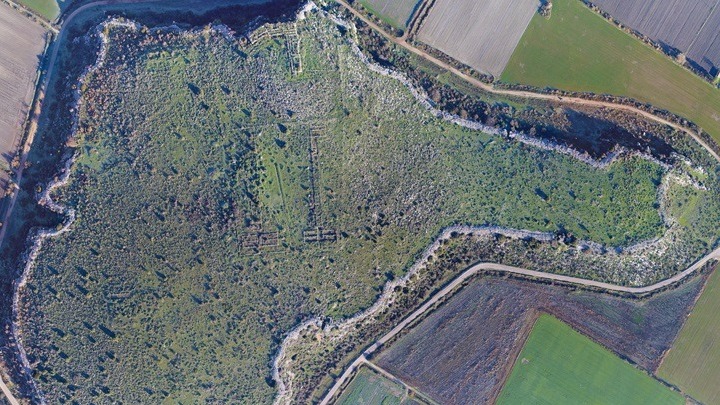Five new 13th-century-BC building complexes were discovered during the last excavation season on the acropolis of Glas, an islet in what used to be Lake Kopais in Boeotia, whose size exceeds by far its better-known contemporary citadels of Mycenae and Tiryns.
In a statement on Tuesday, the Greek Ministry of Culture described Glas as “a remote islet in the middle of the most remote northeast point of Kopais lake, which was founded in the 13th century BC during the drainage of the lake – one of the most impressive and large-scale projects of Greek prehistory.”
The site comprises “the largest Mycenaean acropolis – seven times the size of Mycenae – and has been described by the late archaeologist Spyridon Iacovides as a fortress and an economic and technological operations centre for the drainage works, as well as a collection and processing station for the region’s agricultural production.”
Despite the strategic location, however, and the quick access to the north Euboean gulf and sea transportation, the ministry said, the excavated evidence so far does not prove that Glas played the role that other Mycenaean centres played, “with their multiple-section palaces, numerous archives of Linear B or a Mycenaean acropolis in the normal sense of the term.”
Since it appears from past excavations that the entire acropolis was not occupied even during the apex of Mycenaean culture (around 1250 BC), the ministry said, the role the site played is still unknown and led to the restart of excavations in 2018 following a twenty-year hiatus. “The evident coverage by building remains of only 30 pct of the acropolis, compared to its immense proportions of 20 hectares (200 stremma), have created various questions about the nature and role it played in the political environment of the palace complexes in northern Boeotia (Viotia), especially its relationship with Thebes and Orchomenos,” explained the ministry.
The five new buildings and/or complexes, named temporarily M, N, O, P and Q, are symmetrical and share the same axis. Findings are representative of the Mycenaean era, including vessels, wall painting fragments, lead statuettes, anthropomorphic Mycenaean statuettes, “proving the existence of the familiar, common cultural and artistic tradition of the widespread Mycenaean era,” according to the Ministry.
Unusual findings include sheets and large pieces of lead, clay vessels with decorations, and a complete copper double axe, possibly hidden away before the downfall of Mycenean palaces and the abandonment of all buildings on the site at the end of the 13th century BC, for reasons still unknown. “It appears that the residents took with them the greatest portion of their material culture, following the fate of similar Mycenaean palaces,” the statement noted.
Glas remains unique among contemporary sites: “In contrast to other large Mycenaean acropolises, which show continuous rebuilding activities, Glas shows an aesthetically clear and rare, unified architectural planning. In this manner, the walls and buildings of the acropolis were built under a single construction project and belong, with minor deviation, to a common chronology, within and possibly in the middle of the 13th century BC.”
The 2018-2019 season involved archaeologists and specialists from several disciplines, from Greece and abroad, including students. The project is supervised by the Athens Archaeological Society under Dr. Elena Kountouri (head of the Ministry of Culture’s Directorate of Prehistoric and Classical Antiquities), in close cooperation with the Boeotia (Viotia) Ephorate of Antiquities. Support was provided by the municipality of Orchomenos and the Greek Orthodox community of Panagia Skripous.
The project is funded by the Region of Central Greece, the Paul & Alexandra Canellopoulos Foundation, and the Psychas Foundation.
SOURCE: ANA-MPA
